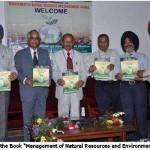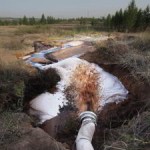But this is not the end of the story. The chemical reaction between the sulfur and nitrate particles with BVOCs also leads to the formation of ozone, which has not only a measurable greenhouse gas effect, but is also harmful to life on earth. However, on balance, unless the level of sulfur pollutants is very high, the warming effect of the ozone formed in this manner is lesser than the cooling effect of aerosols formed through the same process, given that ozone has a very short chemical life in contrast to the aerosol particles which live many times longer. But pollutants with very high levels of sulfur can easily tilt this balance.
If the amount of nitrogen pollutants in the atmosphere is high, the amount of ozone released in reaction with BVOC can significantly alter the nature of ecosystem by suppressing many plant life forms and specifically more micro flora and fauna rather quickly. When the nitrogen content is low, the BVOCs can remove the ozone from the surroundings.

This leads us to an interesting conclusion that while the BVOCs emitted from interior remote forest areas may simply vanish due to their extreme volatility that in and close to urban areas and industries can lead to formation of aerosol clouds as well as higher ozone concentrations on the earth’s surface. Of these, the aerosols perform the function of cooling and, thus, mitigating climate change, while higher concentration of ozone near the land surface can be both harmful to the human life as also have a greenhouse effect of warming.
One could, thus, say that one way of deriving double mitigation benefits from forest would be to have high density of forests particularly of species that emit higher quantity of BVOCs, like pines, poplars, casuarinas, eucalyptus and ficus among many more, near the industrial zones which would increase aerosol particles of light color that would work to reflect sunlight back. In populated areas, however, where the priority is to provide a good environment for the large population living there, keeping the ozone level down has to be higher priority and there the forest planted should be rich in biodiversity and low in BVOC emission rates.
Fires cause higher emissions of BVOCs but any advantage that may accrue from aerosol formation would be far outweighed by the greenhouse gas effect of the carbon dioxide and methane emitted in the process. Pest attack also causes increased BVOC emission, but here too, there would be increased mortality of trees and the decay would result in increased CO2 emission even if less dramatically, and much delayed, compared to fires.
Keeping forests young by earlier harvesting and operations like thinning, coppicing and pollarding that produces consumable forest product replacing fossil fuel based products and increases subsequent carbon sequestration while emitting BVOCs that have the opportunity to deepen aerosol thickness over the earth may perhaps provide a management tool to enhance forest-based mitigation of climate change. But it would require much research before such an idea can be put into practice.
So trees do pollute, but this pollution can be turned to an advantage by getting a double climate change mitigation benefit – one by way of taking away the carbon dioxide from the atmosphere, and the other by providing aerosols reflectors to reflect the sun’s rays back and keeping the earth cool.














